Looking to impress at your next celebration? Whether it’s Christmas, New Year’s Eve, or a special dinner, a beautiful prime rib roast makes any occasion unforgettable! Cooking this iconic cut to tender, medium-rare perfection is easier than you’d think. Try our slow-roasted prime rib recipe for a memorable centerpiece that everyone will love!
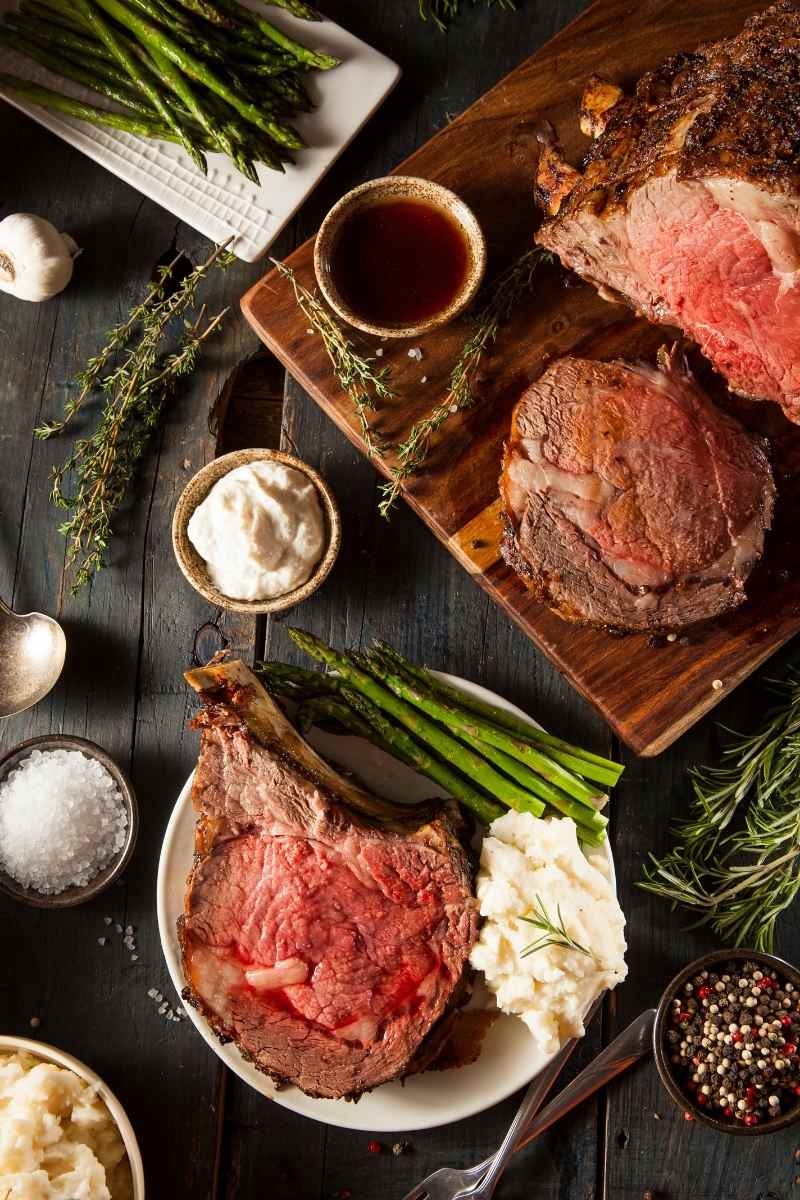
Content Covered Here
Why We Love Our Prime Rib Roast Recipe
- Spectacular centerpiece!
A standing, bone-in ribeye roast looks unbelievably amazing in the center of your dining table. - Feeds a lot of people.
This rich and hearty beef, so just 6-8 ounces will satisfy most appetites. - The leftovers taste just as good the next day.
Our slow-roasted prime rib recipe is so easy and foolproof that it has been shared with countless friends and family. I’m so excited to share it here!
Rib Eye Roast vs Prime Rib?
Also known as a standing rib roast, the ribeye comes from the primal rib section of the steer, the same part of the steer that steaks on the Blackstone and bone-in cowboy ribeye come from. A roast is called Prime Rib when it meets the USDA standard of Prime (a step up from Choice). See more about this in my TFN Pro Tip below!
It it an expensive cut and often is served as the main entree for Christmas dinner or Easter.
Instead of oven roast, consider making a smoked prime rib instead.
🎯 TFN Pro Tip
Although prime rib contains “prime” in its name, it does not necessarily mean that it is USDA Prime grade beef. Therefore be sure to double-check the grading of your beef before you purchase it.
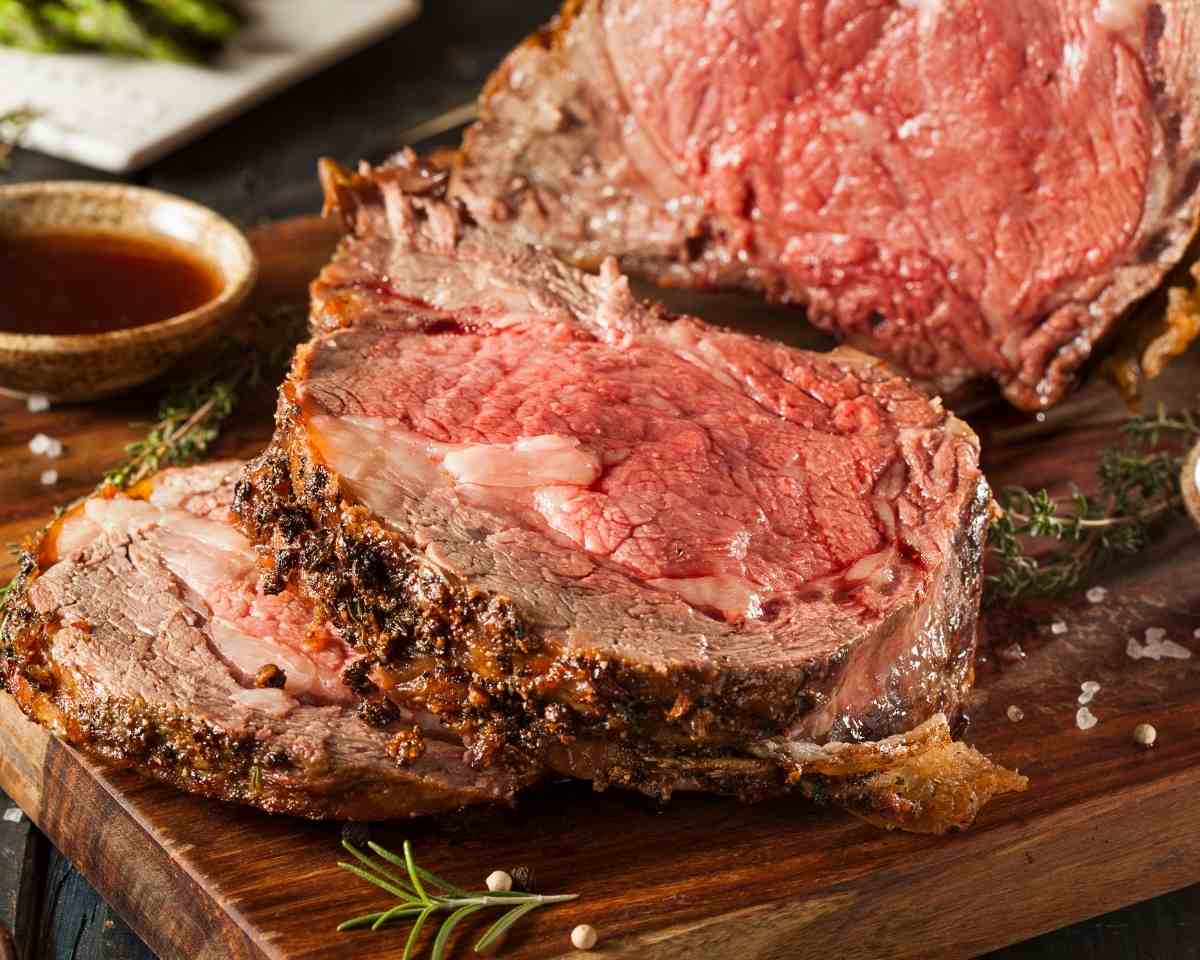
Ingredient Notes and Substitution
But as impressive as this celebratory staple is, the secret is that prime rib is actually quite easy to make. To make this recipe you simply need:
- Standing rib or rib eye roast (more on this below)
- Kosher salt and black pepper
- Vegetable or olive oil
By using just a few ingredients you really let the luxurious flavor of the beef shine. But you can still add herb and spices like garlic powder, thyme leaves, rosemary, or paprika.
And while it might take longer to properly cook a standing rib roast than a meal like recipe pot roast dutch oven, each melt-in-your-mouth bite will be so worth it!
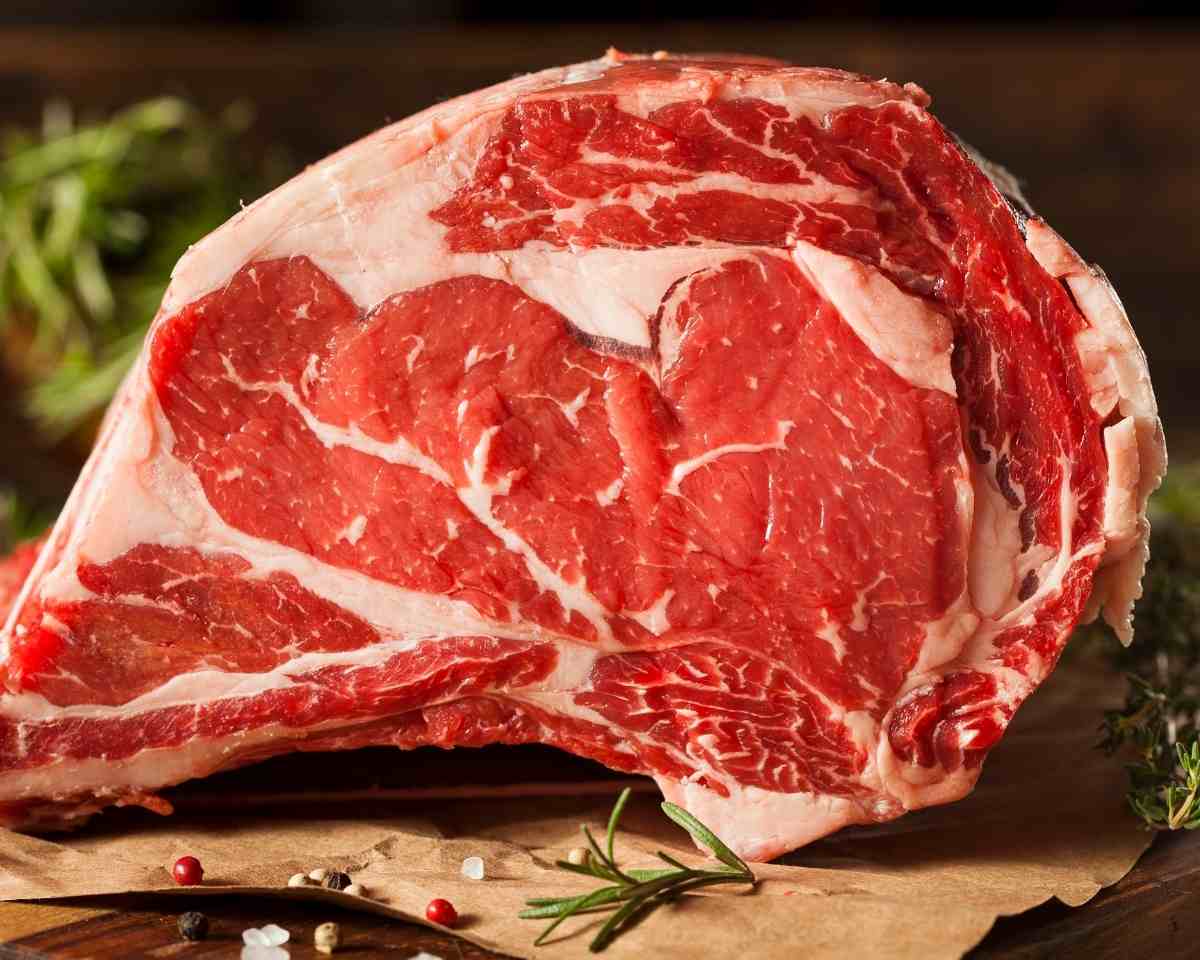
How to Choose the Best Rib Roast
We typically get our Prime cut Prime Rib roasts from Costco, because of the quality of their meat and because their roasts are larger. You can also find quality meat at most larger chain grocery stores, specialty meat shops, and butcher shops.
Bone-in or Boneless?
While both options are delicious, we prefer a bone-in cut, also known as a standing rib roast. The bones actually add flavoring and marrow during roasting. You won’t want to miss that!
Not only are these cuts of meat more flavorful, but you can also actually use the bones to create your own v-rack for roasting. Here’s how:
- With a sharp knife, carefully remove cut bones..
- Once removed, invert the bones beneath the roast.
- Use cooking twine to tie the bones to the prime rib, which keeps them anchored in place.
If your roast is boneless, use a V-rack for roasting, as described in the recipe card at the bottom of this post.
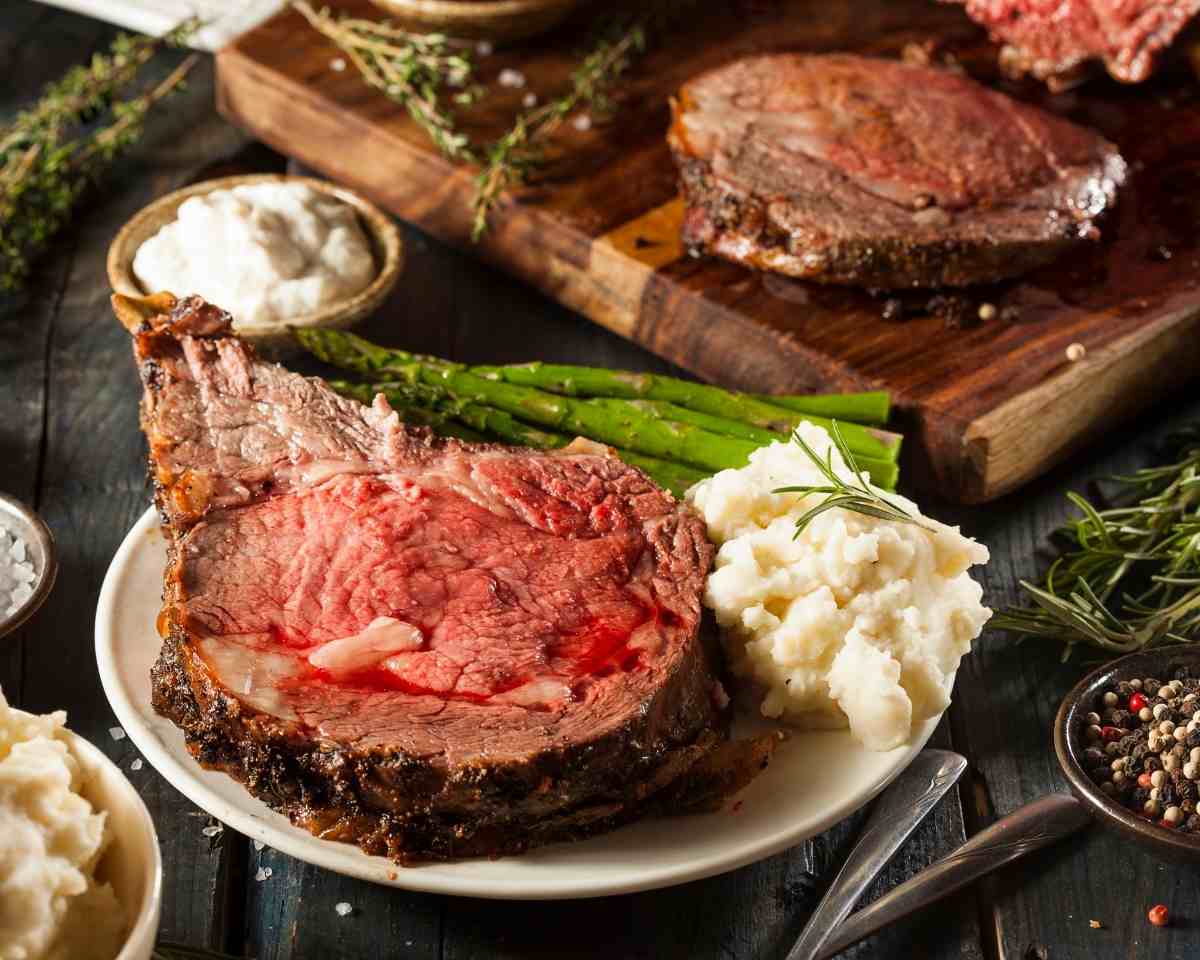
Expert Tips for Cooking a Bone-In Ribeye Roast
- Properly prepare the beef.
There aren’t many steps to prep the prime rib for cooking, but they are all very important to follow. When it’s prepped properly, you’ll end up with juicy, medium-rare beef that’s super tender. - Use a sharp knife to make cross-cuts in the fat pad on top of the rib eye. Be careful to not cut into the meat.
- Rub on the seasonings, then refrigerate for at least 24 hours– This can be done up to 4 full days ahead of time.
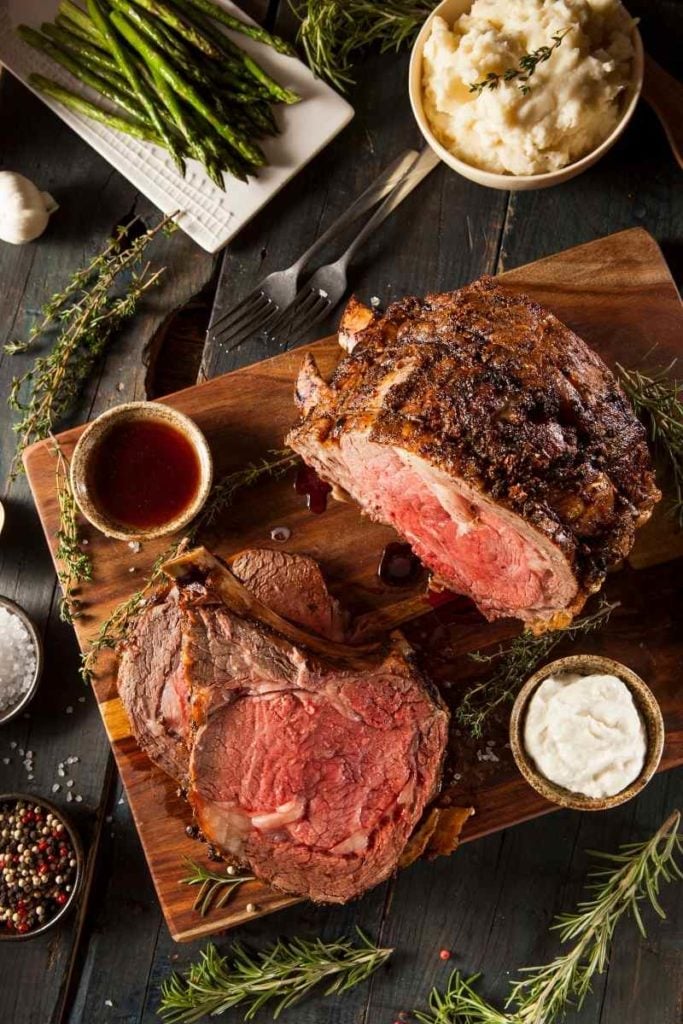
- Sear to help lock in the juices.
It doesn’t take more than a few extra minutes, and trust us, you don’t want to skip this step. - Cook low and slow.
Roast your prime rib in the oven at 200°F. This will allow it to reach medium-rare doneness, without it drying out. - Roast your standing prime rib on the center rack of your oven.
You may want to remove the top oven rack, just to be sure that the oven heat is able to circulate all around the roast.
Let it roast for 3-4 hours., then check the internal temperature with a meat thermometer. Turn off the oven heat as soon as it reads 110°F.
Our secret to cooking a bone in ribeye roast to medium-rare perfection is to turn off the oven when the internal temp of the meat reaches 110°F.
Then, continue to let the it sit in the oven for another 60 minutes until the temperature reaches 125°F.
Remove the prime rib from the oven, and let rest for 15 minutes before slicing. If you cut the meat too soon, you’ll lose all of the flavors in the juices, so don’t rush!
Then slice in 1 to 1.5-inch thick slices, like a steak cut, and serve.
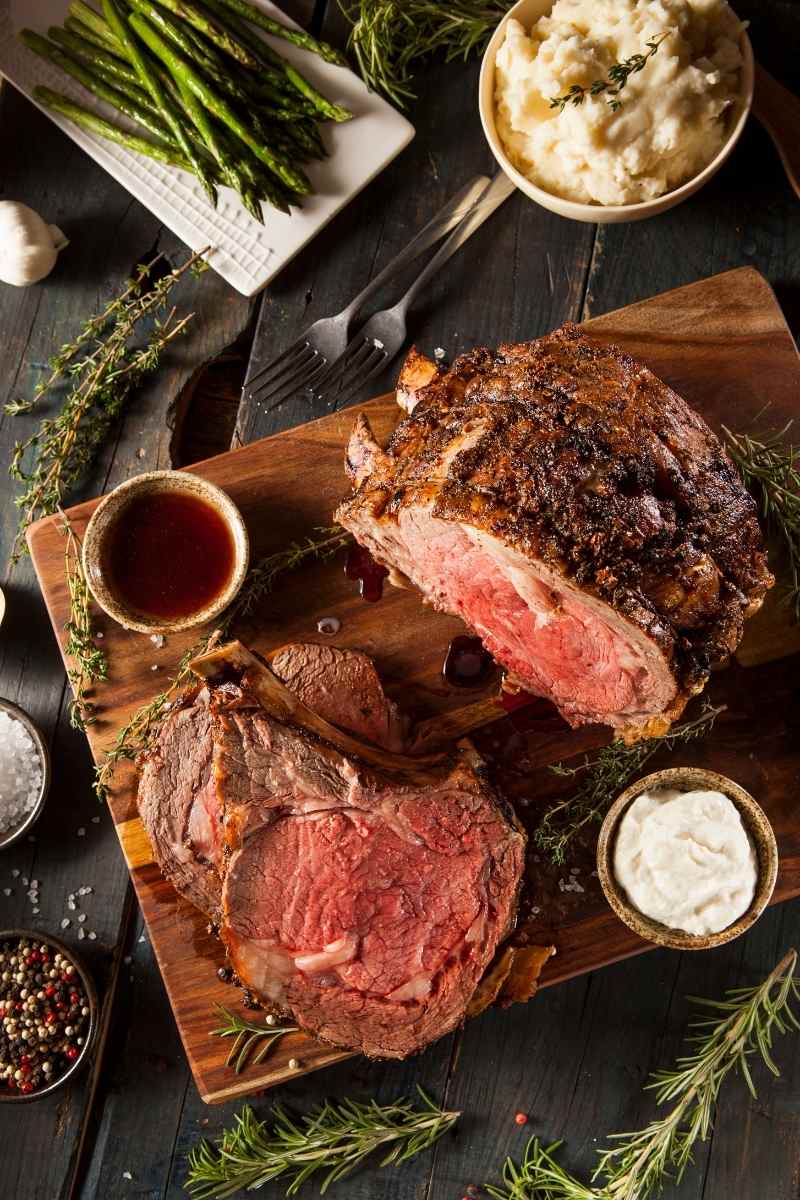
Serving Suggestions
There are plenty of fantastic, impressive, and easy sides to serve with this ribeye roast bone in recipe.
Everyone loves baked or the best instant mashed potatoes recipe, and for a special side, make loaded potato casserole. If you’re looking for a bread side, you can never go wrong with a basket of sourdough soft rolls crust or bread potato rolls!
Learn how to make jello with fruit and serve it with this recipe for the holiday!
Recipe FAQs
Bold and tangy horseradish sauce is classic to pair with tender prime rib. Or try spicy horseradish mustard. You also can serve the pan juices (au jus) on the side.
Leftovers will keep well for up to 4 days in the refrigerator or 3 months in the freezer. Let the roast beef cool completely in a room temperature before transferring to an airtight container. If freezing, I also suggest you wrap the container in a layer of aluminum foil.
Enjoy this ribeye roast bone in recipe roast warm or cold by itself, or used to make other dishes. It’s great on sandwiches and in wraps, salads, or with cheese and crackers for a snack.
More Easy Dinner Recipes To Love…
If you tried this prime rib roast recipe or any other recipe on my website, please leave a 🌟 star rating and let me know how it went in the 📝 comments below. Thanks for visiting!
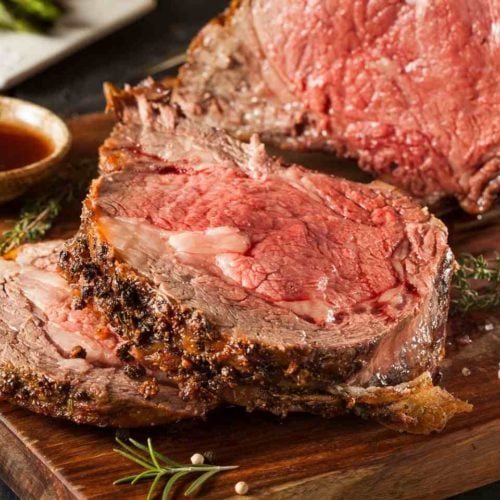
Prime Rib Roast
Equipment
- Baking Sheet
- digital cooking thermometer
Ingredients
- 7 pounds prime rib, standing rib roast, rib eye roast (see notes below for bone-in roasts)
- kosher salt and pepper
- vegetable or olive oil
Instructions
- Make cross-cuts through the fat pad on top of the roast, only cutting through the fat – not the meat. Rub about 2 Tbsp. of kosher salt all over the roast. Refrigerate at least 24 hours and up to 4 days.
- Preheat oven to 200 degrees. Heat 2 tsp of vegetable oil in a 12-inch heavy skillet until just smoking. Brown the roast on all sides, 6-8 minutes total. Let rest for 10 minutes.
- Place the roast on a V-rack or wire rack inside of a roasting or rimmed pan. Season with salt and pepper, and place the oven on a middle rack. Roast until meat reaches 110 degrees (about 3-4 hours).
- Turn off the oven, leaving the roast inside, until meat reaches 125 (for medium-rare). This will take between about 60 minutes.
- Let rest for 15 minutes, then slice into 1" to 1½" thick slices, like a steak and serve.
Notes
- Although prime rib contains “prime” in its name, it does not necessarily mean that it is USDA Prime grade beef. Therefore be sure to double-check the grading of your beef before you purchase it.
- Leftovers will keep well for up to 4 days in the refrigerator or 3 months in the freezer.
- Let the roast beef cool completely before transferring to an airtight container.
- If freezing, I also suggest you wrap the container in a layer of aluminum foil.

Leave a Reply